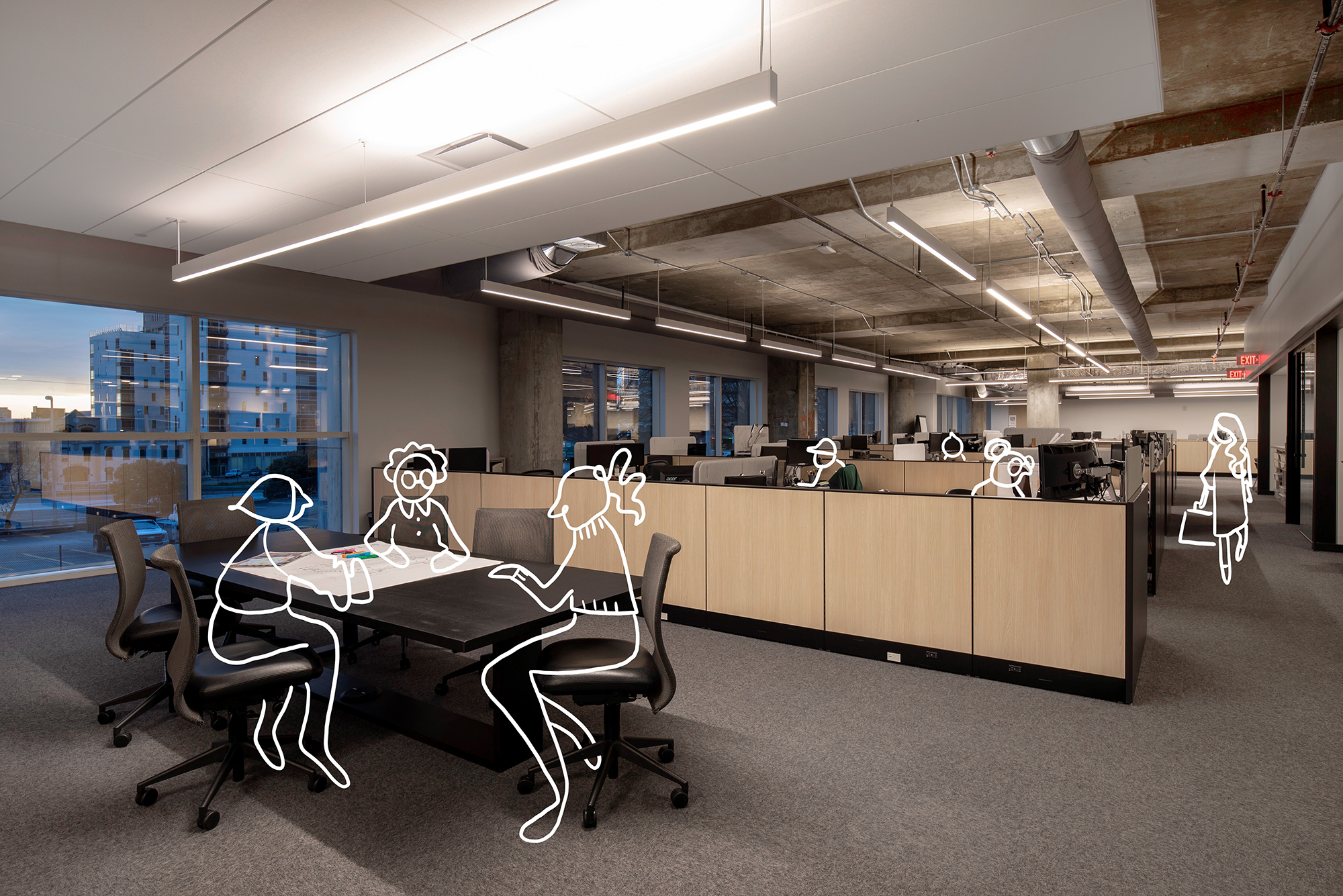In the post-2008 crash, pre-2020 COVID years, “the Office” was on a 10+ year journey of redefining itself. Recognizing that the term “Office” no longer encapsulated what went on within, it underwent a re-brand, emerging as Workplace. The update is much more than a vernacular change — the “place” in workplace is a critical piece of its essence, helping to define how work looks, feels, operates, and behaves. During those years, due in large part to technology, individual spaces got smaller. Group work was recognized for its high value, and spaces were carved out to support it; community spaces got bigger, more plentiful, and more diverse in their layout, furniture and tools. Closed spaces retained a specific use value but changes to their quantity, location, and privacy considerations followed.
Today, after a year or more of fully-remote or hybrid work, conversations surrounding Workplace transformation are decidedly different. Immediate changes were made in 2020 necessitated by health and social concerns, but the future of work environments is really about how we’re using space and why. Global research, and our firm’s own internal data, underscores the critical function of the office: collaboration and connection. Think: mentorship, training, ideation and more. And, as a result, we’ve started to fully understand that heads down work can be accomplished anywhere. Work is no longer a place we go but something we do from multiple settings.

So, where does that leave us? Included here are a number of things we’re observing in current Workplace conversations, but, like all things, what works for one organization may not work for another. That’s why, when we work with clients, our first step is employing our Ask. Listen. Create. methodology, asking probing questions to understand the way you work, and tailoring our concepts and ideas to your organizations’ specific goals, needs, and day-to-day experiences.
- Recognize the impact of hybrid work. Of the numerous studies done over the last year, most land in the same place: approximately 70% of employees indicate a desire to retain a flexible schedule moving forward, expressing a desire to work remotely 2-3 days per week. Moving forward, workplace design needs to address the needs of individual team members (stakeholders, staff) who may, or may not, be in the physical environment full time. With that in mind, strategists must study how individual spaces are being utilized – are they owned, shared, hotel, or hot desks and what combination of solutions best fits the need of your organization?
- Prioritize team and community spaces. Nearly ~95% of employees report they’ve missed the communal aspect of being with their peers over the last year; the problem solving, celebration, and in-person support. What does that mean for space? Shared spaces will likely be specifically authored and defined for set teams or functions in addition to larger more firm-centric community areas like cafes. This may mean flexible or rigid solutions, reservable or owned spaces, and a variety of tools that can flex depending on team need.
- Closed spaces are more important than ever. With video conference and remote work now a standard practice for knowledge employees, private offices, telephone booths, and meeting spaces take on a whole new importance. While they’ve always been valuable for personal discussions and focus work, they’re a key player in ensuring quality experiences for video meetings, client presentations, and more.
- Technology, technology, technology. IT teams have been invaluable over the last 18 months, serving dispersed teams across various platforms and troubleshooting remotely. Reaction time, mirroring abilities, software and hardware implementation, and security will remain a top business priority moving forward. Having the right technology for users wherever they are is paramount to operational success.

- Create an inclusive environment. Consider the diverse needs of your teams (and potential new teammates) in defining a workplace that supports individual expression and inclusion. Solutions range from meditation and wellness spaces to unassigned restrooms, open, unencumbered pathways, accommodations for service animals, and much more.
- Amenities still matter. [They’re just not the same as they used to be.] Amenity spaces of the pre-pandemic past (think: in-office pool tables, beer on tap and gym spaces) are no longer the compelling investment they used to be. Employees now desire spaces with views and connection to the outdoors, storage for bikes and scooters, exterior gathering and touchdown spaces, and access to green space, trails, safe transit options, and various retail and food options. An office’s location, and co-location, matters.
- Define your aesthetic. Warehouse/industrial style is having a moment, due in large part to the built-in charm of exposed brick, large windows and the “blank canvas” vibe it can produce; but this look isn’t for everyone. Understanding your organization’s aesthetic is an important part of how a space comes together.
- Express, affirm, cultivate, and celebrate your culture and brand. Visual and behavioral representations of who you are, what you do, and what you believe are a big deal. There are unlimited ways to express this in the space and should be as original as the organization, and its people, itself. Big moves and small details matter, as long as they are authentic and consistent.
Considering changes to your space that respond to the evolving needs of your team? Reach out to our Workplace team. We’re here to help.


